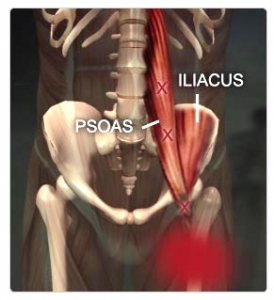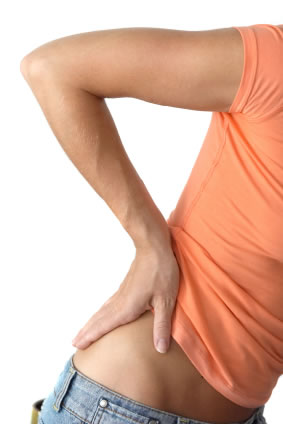Why Tight Hips Might be Causing your Backaches
 It is not all that uncommon to find yourself dealing with a certain level of back pain no matter whether you are sedentary, active or even somewhere in between. As teenagers, you can develop spinal problems just as anyone who might be older. When you start to develop issues, you may find that some of the common courses will include over exercising or over exertion, poor posture, sedentary lifestyle and improper gait. What you may not realize is that a lot of the lower (lumbar-region) back pain that you could be having might be due to the muscles located in your hips. This is where the flexor muscles of the hip end up being overly tight and can then lead to pain that radiates to the lumbar. There can be quite a strong relationship to tight hip flexor muscles and the lumbar pain that you are feeling at any given time.
It is not all that uncommon to find yourself dealing with a certain level of back pain no matter whether you are sedentary, active or even somewhere in between. As teenagers, you can develop spinal problems just as anyone who might be older. When you start to develop issues, you may find that some of the common courses will include over exercising or over exertion, poor posture, sedentary lifestyle and improper gait. What you may not realize is that a lot of the lower (lumbar-region) back pain that you could be having might be due to the muscles located in your hips. This is where the flexor muscles of the hip end up being overly tight and can then lead to pain that radiates to the lumbar. There can be quite a strong relationship to tight hip flexor muscles and the lumbar pain that you are feeling at any given time.
The Relationship Between Hip and Back Pain
What Is A Psoas And Where Is It?
 The deepest hip flexor muscle is called the psoas, which can also be referred to as the iliopsoas. This is because it is found in conjunction with the iliacus which is a similar muscle found on the inner area of the iliac fossa or ilium. The psoas is connected to what is known as the lesser trochanter which is on the femur on the inner portion of the upper leg region. Here, it attaches itself to the vertebrae of the lumbar spine via L1 through L5 as well as T12 along the lumbar. Once the femur is flexed, you will also notice a flexing in the trunk almost like if you were doing a sit up motion. When it comes to your leg, this is the muscle that can bring up the leg whenever you walk upstairs, walk or run.
The deepest hip flexor muscle is called the psoas, which can also be referred to as the iliopsoas. This is because it is found in conjunction with the iliacus which is a similar muscle found on the inner area of the iliac fossa or ilium. The psoas is connected to what is known as the lesser trochanter which is on the femur on the inner portion of the upper leg region. Here, it attaches itself to the vertebrae of the lumbar spine via L1 through L5 as well as T12 along the lumbar. Once the femur is flexed, you will also notice a flexing in the trunk almost like if you were doing a sit up motion. When it comes to your leg, this is the muscle that can bring up the leg whenever you walk upstairs, walk or run.
For dancers, the iliopsoas is a key muscle for whenever they need to lift themselves for jumps. In addition, athletes need the iliopsoas to run or jump. The psoas is number one muscle that can make or break your ability to have proper posture in your back and spine. If you do not have the right amount of length in the psoas, you are not able to walk tall and may even be subject to a constant pull, causing you to hunch forward.
A Locked Short Psoas
The two primary causes of locked short psoas are as follows:
- Over-exercising without stretching: When you exercise, the exertion from physical activity causes the muscles to contract. If not properly stretched, your muscles will tighten and shorten. This becomes increasingly important for the psoas since it is involved in so many physical exercises, particularly running.
- Sitting for extended periods of time: When the muscles remain stagnant, they start to contract. One way to avoid this is to purchase a ergonomic kneeling office chair, the increased angle of the chair actually allows the psoas to remain open and lengthened. These chairs are great for ergonomics in general as they promote proper posture, without any effort from the sitter.
How To Strengthen And Stretch The Psoas
You need to make sure that you are able to lengthen the psoas, especially if you’re sitting for long periods of time. To do this, you will need to take the time to work on AIS, or active isolated stretching. This is a technique that involves the holding of the end portion of the stretch for a few seconds. No matter what, you need to make sure that you avoid over stretching or bouncing during the stretch as it can cause injury. During the stretch, just remember to breathe and go as slow as you can.
In addition, if you want to decrease the negative, painful effects of a locked short psoas, you need to be sure that you work on building your core muscles. It can be difficult to work the abdominal muscles without causing some sort of strain on the neck as well as the lumbar. During crunches, for example, you need to bring the naval inward towards the spine to help engage the abdominal muscles properly. Doing so will allow you to protect your back as these exercises take place. Additionally, these exercises are well known for being able to build up the strength of the iliopsoas without causing additional shortness to the tissues. You can also benefit from a lengthening of the gluteus muscles and the hamstrings during these exercises.
Fascia: The Organ Of Posture
While working with a massage therapist or specialist, you can start to release and reshape the layer around the muscle known as the fascia. It has been said that this fascia is the organ of posture as you can manipulate it by letting go and thus freeing up much needed space within the body. When you do this, you are going to be able to enjoy a much broader and more functional movement. The fascia is popular for being very adaptable tissue because of its elastic properties. Working it properly can help to lengthen all muscles, and especially the psoas.
Please remember to seek medical attention for any serious muscular or spinal issues. Consult with your doctor on whether these exercises are safe for you.

